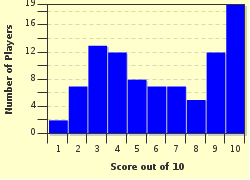Quiz Answer Key and Fun Facts
1. In what year was the International Atomic Energy Agency (IAEA) founded?
2. Which of the following was NOT an original function of the IAEA?
3. Where are the headquarters of the IAEA located?
4. Which two bodies of the United Nations does the IAEA report to?
5. The IAEA and its Director General won the Nobel Peace Prize in 2005. Who was the Director General?
6. Two states have withdrawn from the IAEA (one in 1994 and one in 2003.) Which two are they?
7. The IAEA originated in large part from the "Atoms for Peace" speech given by U.S. President Dwight Eisenhower to the United Nations General Assembly. When was this speech given?
8. Who was the first Director General of the IAEA?
9. The IAEA is made up of three main bodies. What are they?
10. If the IAEA finds a nation to be in serious breach of the Non-Proliferation Treaty, what is the strongest formal action it can take?
Source: Author
Portobello
This quiz was reviewed by FunTrivia editor
trident before going online.
Any errors found in FunTrivia content are routinely corrected through our feedback system.


